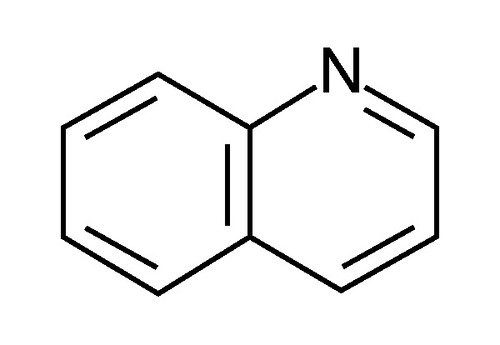Specifications:
| Application | Organic Synthesis | ||
| Storage Temperature | Ambient | ||
| Product Type | Laboratory Chemical | Forms | Liquid |
| Product Brand | Thermo Fisher Scientific™, thermo Scientific | ||
| Product Grade | Analytical grade | Formula | C₉H₇N |
Thermo Scientific™ Quinoline (96%) is a nitrogen-containing heteroaromatic compound with wide applications in organic synthesis, coordination chemistry, and pharmaceutical research. This moderate-purity grade is suitable for general synthetic procedures where trace impurity levels are acceptable. The fused benzene-pyridine ring structure makes quinoline a valuable precursor for dyes, agrochemicals, and heterocyclic drug scaffolds.
Key Features
- 96% Purity (GC ≥95%) – Suitable for general-purpose synthesis and industrial research
- Aromatic Heterocycle – Combines structural features of benzene and pyridine for versatile reactivity
- Refractive Index (20°C) – 1.6230 to 1.6270, confirming material integrity
- Stable Liquid Form – Clear, light yellow to dark brown liquid, easy to handle and measure
- Available in Scalable Pack Sizes – From 500 mL to 10 L for lab and pilot-scale use
Chemical & Physical Properties
| Property | Value |
|---|---|
| Chemical Name | Quinoline |
| CAS Number | 91-22-5 |
| Formula | C₉H₇N |
| Molecular Weight | 129.16 g/mol |
| Purity | 96% (GC ≥95%) |
| Appearance | Clear light yellow to dark brown liquid |
| Boiling Point | 237 °C (760 mmHg) |
| Melting Point | –15 °C |
| Density | 1.095 g/cm³ |
| Flash Point | 101 °C |
| Refractive Index | 1.6230–1.6270 at 20 °C (589 nm) |
| Storage Conditions | Ambient temperature |
| EINECS Number | 202-051-6 |
| UN Number | UN2656 |
| ADR Classification | Class 6.1 (Toxic), PG III |
| Hazard Symbols | GHS06 (Toxic), GHS08 (Health Hazard), GHS09 (Environmental Hazard) |
Applications
- Organic Synthesis – Intermediate for heterocyclic compounds, dyes, and pesticides
- Pharmaceutical Chemistry – Building block for anti-malarial, antibacterial, and antitumor agents
- Coordination Chemistry – Ligand in metal-complex formation
- Agrochemical R&D – Used in synthesis of plant growth regulators and pesticides
- Industrial Chemistry – Precursor in dye and pigment manufacturing
Safety & Handling
- Hazards: Toxic if swallowed, inhaled, or absorbed through the skin; may cause organ damage and is hazardous to the aquatic environment
- Precautions: Use in a chemical fume hood with appropriate PPE (gloves, goggles, lab coat)
- Storage: Keep container tightly closed in a well-ventilated area away from heat or oxidizers
Ordering Information
| Catalog # | Supplier # | Pack Type | Volume |
|---|---|---|---|
| 132195000 | 132195000 | Glass Bottle | 500 mL |
| 132190010 | 132190010 | Glass Bottle | 1 L |
| 132190025 | 132190025 | Glass Bottle | 2.5 L |
| 132190100 | 132190100 | Plastic Drum | 10 L |
Thermo Scientific™ Quinoline (96%) offers consistent performance for general laboratory and industrial applications. Its reactivity as a fused-ring heterocycle and scalable availability make it ideal for both research and commercial chemical synthesis workflows.
- Pack Size: 1L 2.5L 500 mL 10L




 0
0
